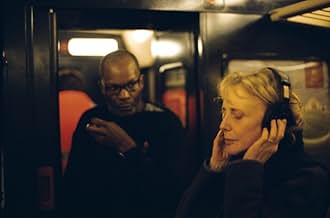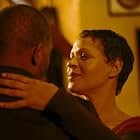VALUTAZIONE IMDb
7,1/10
5385
LA TUA VALUTAZIONE
La relazione tra un padre e una figlia viene complicata dall'arrivo di un bel giovane.La relazione tra un padre e una figlia viene complicata dall'arrivo di un bel giovane.La relazione tra un padre e una figlia viene complicata dall'arrivo di un bel giovane.
- Premi
- 2 vittorie e 16 candidature
Julieth Mars Toussaint
- René
- (as Julieth Mars)
Djédjé Apali
- Martial
- (as Djedje Apali)
Trama
Lo sapevi?
- ConnessioniFeatured in On demande à voir: Episodio #1.22 (2009)
- Colonne sonoreNightshift
Written by Walter Orange, Dennis Lambert and Franne Golde
Performed by The Commodores
Courtesy of Motown Records
Recensione in evidenza
This movie has the subtlety and tenderness of a miniature painting. The charm is hidden in infinitesimal details.
The long opening sequence that watches without haste commuter trains running toward the large city calls in mind Ozu, and, yes, the movie is a tribute to the great Japanese master: a replica to Late Spring, offering at least two surprises.
Firstly, it's Ozu filtered through the lens of Hou Hsiao-Hsien: a replica to Late Spring calling in mind Café Lumière; a French director reenacting a Japanese classic with the sensibility of a modern Taiwanese.
Secondly, while transplanting the Japanese movie from 1949 in today's Paris, 35 Rhums explores other potentialities of the story. Which opens new horizons: after all, the choices made by the heroes in Late Spring raise questions with multiple answers.
Like in Late Spring there is a widowed father with a daughter in her twenties. The father is of African descent, a train engineer at RER (the transit system around Paris). The daughter is studying anthropology. Like in Late Spring, both have a quiet middle-class life in the outskirts of the big city. For the father the same dilemma: realizing that the daughter should leave him and make her own life. Like in Late Spring, there is a prospect groom for the daughter, also a prospect new wife for the father. The friend who got remarried in Late Spring (a warning against loneliness) became in 35 Rhums a coworker just retired and getting quickly alienated by solitude. Even the father's assistant from Late Spring, briefly viewed as a possible match for the girl, is appearing here in 35 Rhums: a colleague of the daughter, briefly trying to date her.
The two stories keep (loosely) the same line. The quiet and warm everyday between father and daughter is disrupted by a chain of totally unconnected events leading to the same conclusion: the daughter will build her own life, the father will face loneliness (getting space now for the 35 shots of rum). Even the trip made by father and daughter before her marriage can be found in both movies: a trip that offers the chance to talk about the long missing mother. The trip in Late Spring is to the ancient city of Kyoto, while in 35 Rhums it is to mother's birthplace: a German town that kept its medieval allure. But the similarities between the two movies end here.
Unlike the Japanese classic, 35 Rhums is not interested at all in the plot. Without making the connection to Late Spring you wouldn't get it too much. You would realize at some point that both father and daughter speak also German fluently, you should then realize that the mother was (maybe) born in Germany, you wouldn't get it what's with the 35 shots of whatever, and were you to be too stubborn, you wouldn't even get it who's getting eventually married with whom.
And that is because for the French director it is the web of human relationships that counts. Human relations, their warmth, their potentialities, never totally fulfilled, the never told dreams and hopes, the brief looks that speaks tones of volumes where words would say nothing, this is what Claire Denis is looking for in this movie. Discovering the unseen light that comes from within, celebrating it as infinite joy, and infinite ambiguity, of love; celebrating the mundane as scene for this ambiguous, pure, infinite, love. It's Ozu seen through the lens of Hou Hsiao-Hsien, a classic story subtly re-told with contemporary sensibility.
This fluidity of the plot offers room for ambiguity: ambiguity of what's happening, ambiguity of sentiments. Father and daughter have built a universe of their own where they feel perfectly fine, all other relations (the father with the woman who loves him, the daughter with the man whom she eventually will marry) are kept in some sort of a backup, never rejected, never properly treated, just delaying them for later, for that 'you never know'. This while all feel that time never stops, never comes back, never repeats lost occasions.
There is a superb scene that shows all this. Father and daughter, along with their prospects, are going to a concert. The car breaks, it's raining hardly, and they notice a small African restaurant. It's closed, they knock at the door, the owner reopens for them. A drink to get warmed, while the owner prepares some quick dishes, they start to dance, the father with his girlfriend, then with his daughter, the young man with the daughter, the father with the young waitress, each pair is exhaling a sense of intimacy noted with a vague discomfort by the others, while this intimacy is actually filling the whole space, is conquering everybody.
Well, you would ask me what's about with the 35 shots of rum? C'est une vieille histoire (it's an old story) says the father when asked... but you should see the movie for yourselves to understand.
The long opening sequence that watches without haste commuter trains running toward the large city calls in mind Ozu, and, yes, the movie is a tribute to the great Japanese master: a replica to Late Spring, offering at least two surprises.
Firstly, it's Ozu filtered through the lens of Hou Hsiao-Hsien: a replica to Late Spring calling in mind Café Lumière; a French director reenacting a Japanese classic with the sensibility of a modern Taiwanese.
Secondly, while transplanting the Japanese movie from 1949 in today's Paris, 35 Rhums explores other potentialities of the story. Which opens new horizons: after all, the choices made by the heroes in Late Spring raise questions with multiple answers.
Like in Late Spring there is a widowed father with a daughter in her twenties. The father is of African descent, a train engineer at RER (the transit system around Paris). The daughter is studying anthropology. Like in Late Spring, both have a quiet middle-class life in the outskirts of the big city. For the father the same dilemma: realizing that the daughter should leave him and make her own life. Like in Late Spring, there is a prospect groom for the daughter, also a prospect new wife for the father. The friend who got remarried in Late Spring (a warning against loneliness) became in 35 Rhums a coworker just retired and getting quickly alienated by solitude. Even the father's assistant from Late Spring, briefly viewed as a possible match for the girl, is appearing here in 35 Rhums: a colleague of the daughter, briefly trying to date her.
The two stories keep (loosely) the same line. The quiet and warm everyday between father and daughter is disrupted by a chain of totally unconnected events leading to the same conclusion: the daughter will build her own life, the father will face loneliness (getting space now for the 35 shots of rum). Even the trip made by father and daughter before her marriage can be found in both movies: a trip that offers the chance to talk about the long missing mother. The trip in Late Spring is to the ancient city of Kyoto, while in 35 Rhums it is to mother's birthplace: a German town that kept its medieval allure. But the similarities between the two movies end here.
Unlike the Japanese classic, 35 Rhums is not interested at all in the plot. Without making the connection to Late Spring you wouldn't get it too much. You would realize at some point that both father and daughter speak also German fluently, you should then realize that the mother was (maybe) born in Germany, you wouldn't get it what's with the 35 shots of whatever, and were you to be too stubborn, you wouldn't even get it who's getting eventually married with whom.
And that is because for the French director it is the web of human relationships that counts. Human relations, their warmth, their potentialities, never totally fulfilled, the never told dreams and hopes, the brief looks that speaks tones of volumes where words would say nothing, this is what Claire Denis is looking for in this movie. Discovering the unseen light that comes from within, celebrating it as infinite joy, and infinite ambiguity, of love; celebrating the mundane as scene for this ambiguous, pure, infinite, love. It's Ozu seen through the lens of Hou Hsiao-Hsien, a classic story subtly re-told with contemporary sensibility.
This fluidity of the plot offers room for ambiguity: ambiguity of what's happening, ambiguity of sentiments. Father and daughter have built a universe of their own where they feel perfectly fine, all other relations (the father with the woman who loves him, the daughter with the man whom she eventually will marry) are kept in some sort of a backup, never rejected, never properly treated, just delaying them for later, for that 'you never know'. This while all feel that time never stops, never comes back, never repeats lost occasions.
There is a superb scene that shows all this. Father and daughter, along with their prospects, are going to a concert. The car breaks, it's raining hardly, and they notice a small African restaurant. It's closed, they knock at the door, the owner reopens for them. A drink to get warmed, while the owner prepares some quick dishes, they start to dance, the father with his girlfriend, then with his daughter, the young man with the daughter, the father with the young waitress, each pair is exhaling a sense of intimacy noted with a vague discomfort by the others, while this intimacy is actually filling the whole space, is conquering everybody.
Well, you would ask me what's about with the 35 shots of rum? C'est une vieille histoire (it's an old story) says the father when asked... but you should see the movie for yourselves to understand.
- p_radulescu
- 7 nov 2010
- Permalink
I più visti
Accedi per valutare e creare un elenco di titoli salvati per ottenere consigli personalizzati
- How long is 35 Shots of Rum?Powered by Alexa
Dettagli
- Data di uscita
- Paesi di origine
- Siti ufficiali
- Lingue
- Celebre anche come
- 35 Shots of Rum
- Luoghi delle riprese
- Gare du Nord, Paris 10, Parigi, Francia(train tracks close to Gare du Nord)
- Aziende produttrici
- Vedi altri crediti dell’azienda su IMDbPro
Botteghino
- Budget
- 3.599.757 € (previsto)
- Lordo Stati Uniti e Canada
- 177.511 USD
- Fine settimana di apertura Stati Uniti e Canada
- 9.576 USD
- 20 set 2009
- Lordo in tutto il mondo
- 973.539 USD
- Tempo di esecuzione1 ora 40 minuti
- Colore
- Mix di suoni
- Proporzioni
- 1.85 : 1
Contribuisci a questa pagina
Suggerisci una modifica o aggiungi i contenuti mancanti

















